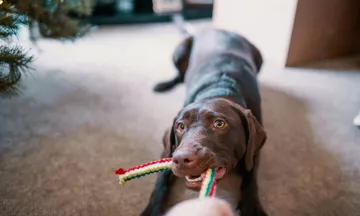It seems like it will never end: your pet's summer coat falls out and you find tufts of fur all over the place. What is moulting exactly? What can you do to make things as comfortable as possible for your dog or cat, and what should you avoid doing?
A dog or cat's coat is amazing - it regulate's your pet's body temperature and keeps their skin dry, clean and healthy. Twice a year, when it gets warmer or colder, most dogs and cats suddenly shed a lot of fur. This moulting period can take up to 3 or 4 weeks and can cause a lot of irritation to both pets and their owners. With some cats and dogs, the fur loss seems never-ending, with truly impressive quantities of fur! It is important to know what you as a pet owner can do during this period.
Know your dog or cat's fur
Every dog or cat's coat is different: the duration and intensity of the shedding varies between individual breeds. Therefore, each dog or cat will need a different approach when it comes to coat care. Some pets shed a constant amount of fur throughout the year. Consider, for example, dogs and cats with wooly or curly coats, such as Labradoodles or Cornish Rexes, which might shed continuously throughout the year. Loose hairs must therefore be brushed out regularly. On top of this, some dogs and cats with longer coats may not physically lose all of their seasonal fur. Twice a year, some long-haired dogs in particular should be groomed by a specialist to remove the old hair and release the new undercoat. It is important that these dogs and cats get the right coat care: if you do not brush a long-haired dog in time, the hair will start tangling and the fur will become dirty and smelly.
Dogs and cats with smooth or short fur also shed all year round, but twice a year at the changing of the seasons they will suddenly lose A LOT of fur. Now that it is getting colder, many dogs and cats will lose their summer coat and exchange them for a thicker winter coat. The result: you will find fluff all over the house. What can you as a pet owner do during this period?

Moulting is natural and healthy
Dogs and cats do naturally 'groom' their own fur to an extent as their coat largely regulates itself. During the moulting period, wild dogs and cats would take care of their own fur by licking or rubbing their fur against bushes to get rid of excess hair.
Moulting is naturally triggered through temperature and light. When the seasons change, the animal's coat responds to the new circumstances. But because dogs and cats nowadays often live indoors, that balance gets disturbed. During winter, for example, your pet may also spend a lot of time indoors by the heater. And during the summer they also experience a lot of temperature shifts: from the warm outdoors to the air conditioning indoors. Additionally, we humans have bred long-haired and wire-haired breeds. Therefore we need to step in and give our cats and dogs a hand in taking care of their fur.
Brushing: yes or no?
Regular brushing removes excess fur and gives long-haired dogs some relief of itchiness and discomfort, especially during the shedding season. For short and smooth-haired dogs and cats, it is better to gentle with the brushing. Outside the moulting season, you can brush your dog or cat less frequently as too much brushing can cause skin damage.
Make sure to always choose the right dog or cat brush. For dogs with a shorter coat, use a soft brush (such as a rubber brush or a bristle brush). For dogs with a longer, wired coat you can use a comb or slicker brush. For long-haired cats, a comb to detangle might be necessary, and a deshedding brush or glove for short-haired cats (which can really help to reduce fur-balls). Do not press too hard in the fur so you don't irritate the skin.
To prevent tangling on pets with long fur, it is important to pay extra attention:
- Around the ears
- At the nose / mouth
- In the armpits
- Around the soles of the feet and between the toes
- Under the tail
Are you hiring a dog sitter for an overnight stay or for doggy daycare, or a cat sitter to come do home visits? Then tell your sitter about your pet's coat and give your sitter the right brush. Make clear arrangements with your pet sitter so that he or she knows what's best for your dog or cat's fur.
Bathing or not?
During the moulting period, bathing can provide a bit of relief for some long-haired dogs. The running water and the use of a neutral-scented dog shampoo can loosen some of the dead hair. Afterwards, blow-dry the coat with a dryer to prevent the fur from tangling. You can do this 1-2 times during the shedding season. Dogs and cats with a short or silky coat don't need to be shampooed unless they are really dirty after rolling in smelly stuff or if they have a medical condition. Too much washing can disturb the natural balance of the skin and coat. Read more about why dogs can be smelly.
Furthermore: A healthy dog or cat has a healthy coat - that is why a wholesome and balanced diet is always so important - especially when they are shedding. Does your dog or cat lose a lot of hair outside the shedding season? Do you see irritation, itching, redness or bald spots? Then there may be a sign of a health issue such as stress, an infection or vitamin deficiency, so be sure to visit your vet.
What about the hairs all over the house?
We're afraid you will be doomed to some extra vacuuming... But fear not....a daily brush will limit the hair loss on your floors and furniture. Here are a few tricks to get rid of the excess dog and cat hair around the house.




